

LinkedIn by Morten Kamp Andersen. The Hard and Soft Sides of Change Management: Tools for Managing Process and People (23 March 2021) by Kathryn Zukof. Change Management: Fundamentals and Success Factors (24 October 2021) by Thomas Lauer. The Science of Change Management. The types of changes that require change management. Change management contributes to the success of a wide range of organizational changes “Is change management necessary for this project?”
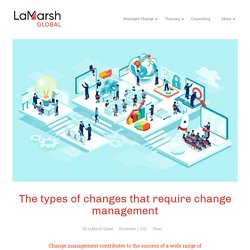
Most often when this question is asked, the answer is yes. But the intent of the question itself is rarely regarding the true necessity of change management. Whether it is being asked by leaders, managers, project teams or employees, people are often more concerned about the resources required, perceived delays or any personal impacts. Gestion du changement : et si on changeait d’approche? La gestion du changement n’est plus ce qu’elle était : désormais, on ne parle plus de coffre à outils ou de livrables, mais plutôt d’une habileté à renforcer la capacité à changer de l’organisation, de façon à atteindre les résultats d’affaires voulus.
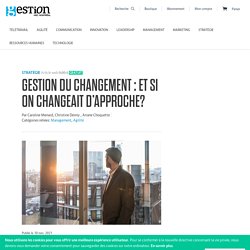
Décentraliser la gestion du changement. La multiplication des changements amène les organisations à revoir les façons de faire.
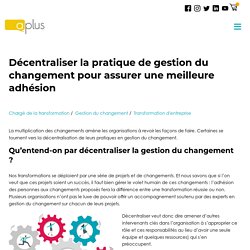
How to approach Change Management. On demand webinar: Introduction to Change Management. Yes, You Can Quantify Change Management's Value. Change practitioners often struggle to measure the contribution of change management to the success of a change in a tangible way. The factors contributing to the struggle include lack of alignment on the definition of success, not establishing specific success metrics, and failing to collect the necessary data. These struggles contribute to the misconception that the value of change management can’t be measured. By following Prosci’s holistic approach, you can quantify and measure the contribution of change management to benefits realization for the change initiatives you are supporting. The Soft Stuff Really Is the Hard Stuff. You have probably heard the phrase, “the soft stuff is the hard stuff,” meaning that the tools and techniques are actually easier to do than the “softer” issues, like leadership, alignment, teamwork and managing cultural change.
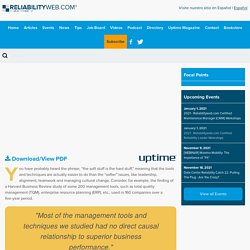
Consider, for example, the finding of a Harvard Business Review study of some 200 management tools, such as total quality management (TQM), enterprise resource planning (ERP), etc., used in 160 companies over a five-year period. "Most of the management tools and techniques we studied had no direct causal relationship to superior business performance. " Supporting this conclusion are various reports that indicate the more popular tools and techniques do not have a very high success rate. For example, Bob Williamson, an industry expert in total productive maintenance (TPM), estimates that some 60 percent of TPM programs fail after three years of effort and 98 percent of 5S programs in the U.S. over the past 15 years have failed.
The Theory and Practice of Change Management 6th Ed (15 November 2021) by John Hayes. Change Management-The Science vs. The Implementation Models. Change vs. Change Management. Change and change management can seem interchangeable in organizations, but there are significant and important differences between the two. And when there is no clear delineation, people can lack clarity about what is needed to move a change initiative forward. Change Management Principles. The new change manifesto. The secret in understanding the core of change management. The What, Why, Who and How of Change Management. Do you want to engage organizational leaders and increase their understanding of change management in a matter of minutes? This overview provides the foundation they need—the what, why, who and how of change management—so you can quickly explain the benefits your organization can achieve by focusing on the people side of change.
What Is Change Management? Change management is the application of a structured process and set of tools for leading the people side of change to achieve a desired outcome. Change management is also: A process used to manage system, process and organizational changesA leadership competency for enabling change within an organizationA strategic capability designed to increase change capacity and responsiveness. Podcast: A deep dive into Change Management with Tim Creasey. In this episode, Dale and Val talk about skills from other professions and how the application of fusing new skills could provide improved ways to manage projects.
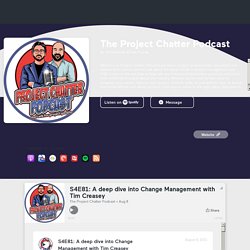
We're joined by two experts in this field, Carole Still and Jamie Hannon. Carole is an award-winning International Educator, United Nations Executive Coach, Chartered Manager, Mediator, and NLP Master Practitioner, Carole has worked in the public and private sectors, spanning the NHS, Accountancy, and Higher Education for 40 years. Her lecturing expertise spans Leadership, Workplace Psychology, Change management, Mediation, the Art of Networking, and Conflict Resolution. In 2009 she co-founded Simply Business Skills, a skills-based training company before closing the company in 2014 and donating all its learning resources to Coventry University London.
Managing change management. Ingredients for your OCM Secret Sauce? Target Resistance How can you tell from a survey or focus group that there will be resistance to change?

Look for perceived lack of communication, poor cross-business coordination, fears surrounding other changes within the organization, and other root causes that will eventually manifest into resistance to your digital transformation project. Keep in mind that most resistance is unintentional and below the surface, so it takes experience to identify them. Once you dial in on the root causes of resistance that your employees will likely show, target it.
Sprinkle a bit of sugar over the things that might hold them back and make the new normal appear a bit sweeter. Encourage Ownership Change is all about perception, and influence is birthed from perceived value. Mix these ingredients with the base, your company’s culture, and you’ll have an irresistible secret sauce that will drive your team to a successful software implementation. What is open-source change management? This is a challenge that has become especially evident for companies around the world over the past 6 months due to the COVID-19 pandemic.
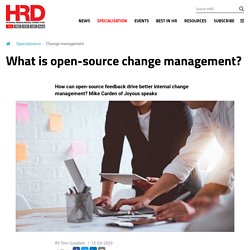
Change has been thrust on companies and employees alike, both by external factors and by default as the world adjusts to the so-called “new normal.” “Being redeployed from the office to the home environment is chaotic enough,” says Carden. “On top of that, you’ve had plenty of businesses introducing additional changes in the wake of what was already a highly disruptive shift.” Factsheet: Change Management. It’s clear that change is complex and there isn’t a single solution to managing it.

However, a number of key areas of focus emerge. Our transformational change research, in collaboration with the University of Bath, identifies ten techniques, across three themes, which can be applied to a variety of change management scenarios to enhance the effectiveness of change programmes. However, whilst these areas should always be considered, the pace of change sometimes dictates the need for a more rapid response.
In these situations, the areas below that touch on communication and voice are, arguably, the most important to ensure the best possible result in difficult circumstances. Designing the transformation Leaders and designers of change need to be able to ‘read’ their context; to evaluate it to identify aspects that hinder change. What is change management to you? The Business and Personal Nature of Change Management. Time and task management are two critical skillsets small business owners need to have.

A highly developed focus can help ensure all operational functions of your business run smoothly and that projects are delivered on time. Many of the skills that you use in business management can also serve important purposes when they’re employed in your personal life, helping you create an overall healthy work-life balance. Business Planning Many small business owners think they only need to develop a business plan once as a way to outline objectives and potentially apply for funding. However, a business plan should actually be a living document that helps guide the way your company operates and evolves over time. What is Organizational Change? (with examples) But “organizational change” is a broad term that encompasses different flavors of business environment optimization: Incremental change: Improving existing approaches and building on pre-established processes.
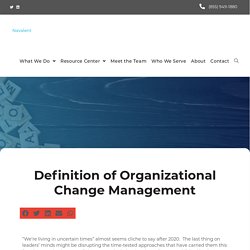
For example, an equipment manufacturer integrating new SKU tracking tools to improve supply chain efficiency and inventory visibility. Or implementing a new performance management process to help strengthen talent development.Transitional change: A shift away from an existing state into a type of better, more efficient workflow. Examples may include outsourcing business processes to a third-party vendor — or two technology companies merging to provide new services and reclaim lost market share.Transformational change: Significant changes that fundamentally alter culture, strategy, structure, governance and operations to better support business goals.
What is change management? Annotated References "Access CTSI Services to Enable Research. " Training in Implementation Science. UCSF Clinical and Translational Science Institute (CTSI). COACH U Change Management with Cindy King Trim. What’s wrong with theories of change? The phrase ‘theory of change’ is bandied around throughout the world of social action. We at Nesta use it quite a lot, and encourage organisations we fund to work on their theory of change. When I first arrived at Nesta I tried to discourage my colleagues from using the phrase and circulated a critique. That had no effect at all. Change Leadership vs. Change Management. Moving with urgency to actualize big visions. One of my core messages to CEOs, team leaders, and middle management is rooted in the work of Harvard Professor and friend, Dr. John Kotter, leadership expert and business visionary. For years the business world has functioned the same way with the same hierarchical system, under the same unspoken set of rules and guidelines.
What Is Change Management And Why Does It Matter. Change Management Is A Mindset. We were recently asked to share our approach to change management with an organization driving multiple simultaneous transformation efforts. When we did, they were quite disappointed to learn that we weren’t going to share the “7 easy steps to change management.” They wanted a simple recipe, but we believe that catalyzing change in human systems is an art, not a science. Step-by-step methodologies look good on paper, but rarely, if ever drive long-term sustainable change.
Here are a few things we’ve learned over the years about making change happen. It Starts And Ends With Leaders. For example, in one organization the leader was espousing the need to “be innovative and push the boundaries!” “We’ve tried that and it didn’t work…” What would your answer(s) be? “Change management and ____ go together like peanut butter and jelly.” CHANGE MANAGEMENT - Step# 3 - Impact Study. Change Management Post COVID-19. Quantifying the Value of Change Management with Data. The value of Change Management in contributing to a project’s success is now largely recognised, but it has been hard to quantify for various reasons. There is often a misconception between the definition of change leadership and change management. Change vs. Change Management. CHANGE MANAGEMENT: Step #1 - Change Management Diagnosis. There's NO Such Thing as "Soft Skills" Change Management Is Like Product Management. The Four Stages of Change Management. I took my daughter to an orthodontist appointment yesterday to see when she should get her second round of braces.
Yes, she has to get braces again! She had braces for most of 2019, and by the end, her teeth had all been straightened. What Is Change Management? How to Explain Change Management - Prosci Unified Value Proposition Statement. La conduite du changement - Partie 2. L’aberration « Gestion du changement » : Le changement ne se gère pas, il s’accompagne. Depuis toujours, nous sommes confrontés à des changements plus ou moins importants, aux niveaux privé, professionnel, personnel et sociétal. Antoine Lavoisier, chimiste, philosophe et économiste français, avait en 1789 fait passer du statut de maxime philosophique, à celui de principe physico-chimique, cette maxime inspirée du philosophe Anaxagore : « Rien ne se perd, rien ne se crée, tout se transforme. » Confrontés à ces changements, les entreprises et organisations ont voulu y faire face. Dès lors, des « recettes » ont été définies pour gérer et conduire ces changements. Ces recettes, souvent mal appliquées, ne permettent que rarement d’avoir un vrai succès dans un projet de changement.
Change Management vs Change Control. Operational Excellence Definition for Management of Change (2013) How do we manage the change journey? In Beyond Performance 2.0: A Proven Approach to Leading Large-Scale Change (John Wiley & Sons, 2019), McKinsey’s Scott Keller and Bill Schaninger draw on their long experience, and the most comprehensive research effort of its kind, to provide a practical, proven guide for executives managing corporate transformations. “A better way to lead large-scale change,” the first article in the series, explains how and why the authors’ approach works. The second, “Getting personal about change,” provides an in-depth look into the mind-set shifts required for generating meaningful change.
The third, “The forgotten step in leading large-scale change,” examines the most often neglected stage of the change process. This fourth article discusses how to generate ownership and energy for success. Stages in Organizational Change Management. Association for Talent Development (ATD) How Is Digital Transformation Different From Change Management? Change Management: Unified by a Dedication to People. Change management is / is not document. Why The Little Things Do Count In Change Management. Business transformation is often associated with big, bold changes that can redefine the company, industry, and if you’re lucky, the entire marketplace. People come up with all sorts of new products, services, processes, and experiences that they hope will stick for the long term. But no matter how fantastic they are, most of these ideas never seem to deliver as expected. Businesses are more inspired than ever before.
But, as Adam Fridman, founder and CEO of ProHabits and co-author of The Science of Story, reminded me during a recent conversation, all of this passion and excitement is really daydreaming without putting action behind it. Animation: What is Change Management? Cart Member Login Connect. The New Classics of Management. Predictors of effective change management: A literature review by William Makumbe (2016) Top 13 change management comic strips.
Difference between change leadership & change management. Change management is how we cross the chasm from solutions to results ... Definition of Change Management. Tim Talks: What Makes Change Management Meaningful Work? (On demand short webinar) Planned Change Management and Why You Should Care. Council Post: Opportunistic Change Management Methodology. Change Management for Beginners: Understanding change processes and actively shaping them (2019) by Steffen Lobinger. LinkedIn by Isabelle A. The Why Behind the Five Levers of Change Management. Change Management in Five Questions - Prosci (based on the Five Tenets of Change Management) (On demand short webinar) The change management mind-set: Getting personal. Managing change as a change driver – Infographic. Cultural Context in Change Management - Webinar Short.
Change vs. Change Management. Change management perception. Change management: Do it right. The fundamentals of change management. Change Management for a Fast Moving World. Change Management is Like Growing a Garden. Future Change Management. Change Management Needs An Update To Bring Meaningful Change. Change Management in 10 Minutes.